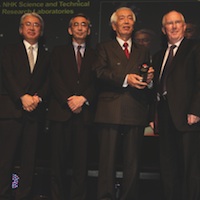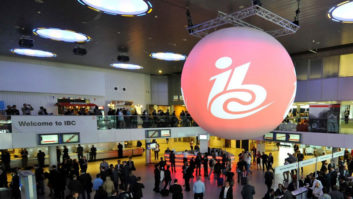
At the IBC Awards Ceremony last night tributes were paid to an institution which has led the industry for more than 80 years, and a new standard which will be the platform for developments yet to come.
In contention for awards were home networking and remote production; a greenfield site and a new way of controlling a 50 year old sport; and vampires and ballroom dancing. The evening ended with a fresh look at the thrilling coverage of the London 2012 Olympic Games.
IBC’s highest award, the International Honour for Excellence, went to the Science and Technical Research Laboratories of NHK. First established in 1930 in Tokyo, the labs have been involved in a staggering line of innovations, including colour television, HD, satellite broadcasting, the plasma display and many more.
The international judging panel chose to give its Judges’ Prize to FIMS, the Framework for Interoperable Media Systems. This initiative, jointly promoted by AMWA and EBU, recognised the need for standardisation in file-based content exchange. It brought together not just all the vendors but many of the world’s leading broadcasters, too, in an initiative that will form a platform for inter-working in the future.
Jean-Pierre Evain of EBU commented “A few years ago I made a presentation at the IBC conference about service oriented architectures, and I would never have dreamed of results coming so fast to the market. The people who have been working on FIMS have been excellent, and the industry is recognising this effort.”
This year’s award for the Best Conference Paper was also forward-looking. Christian Reichert of the Fraunhofer Institute accepted, on behalf of his co-authors, the prize for their paper which describes the algorithms required to convert stereoscopic 3D television into multi-channel signals needed for autostereoscopic screens. Their work will, in due course, be implemented inside millions of television sets to bring glasses-free 3D to the home.
The centrepiece of the evening, though, was the IBC Innovation Awards, which are unique in looking beyond technological innovations to the way they are implemented. The awards go to the broadcaster or media enterprise which has taken the best of new technology to solve a real creative or operational challenge.
Shortlisted for the award for most innovative application in content creation was ESPN for the way it uses tracking technology to add graphics to sports, helping the viewer understand the dynamics and strategy of the game; and TV Globo for a clever way of supporting the director and cameramen in live and unpredictable events like Dança dos Famosos, the Brazilian version of Strictly Come Dancing.
With much talk of multi-screening at IBC this year though, appropriately, the award went to a second screen service. FX UK worked with Red Bee Media and Civolution on an iPad app which was synchronised to the television using audio watermarking, allowing the audience to time-shift the programme but still enjoy the added value.
Competing for the prize for content management was a brand new television station built from the ground up, Sky News Arabia, and the way that Turner Sports keeps track of two million new sports highlights a year.
The winner was also a sporting application, but not for a broadcaster. Fast and furious American motorsport NASCAR needed a way to give race officials instant replays of incidents and accidents from multiple angles. The answer came in a new application developed by technology partner Telestream.
Four projects made it to the shortlist of most innovative work in content delivery. CBS Sport had used video conferencing technology to take a radio show produced in Louisiana and broadcast it for television through its New York hub; ITV in the UK had used technology from Yospace and Snell to seamlessly replace content in multi-platform delivery; and DIRECTV has developed a standards-based home network system, allowing subscribers to watch what they want, where they want.
The award went to 4OD, the on-demand service from Britain’s Channel 4. Their witty video described how Kit digital had built an app for the Microsoft Xbox and Kinect to allow viewers at home to use gestures and voice commands to find the programmes they want. Not only is it clever and fun, it has proved massively popular with consumers.
Glasses-free 3D takes conference honour
Many feel that 3D in the home will only achieve mass popularity when we have stable pictures from different angles without glasses. While display manufacturers are actively working on their own solutions, inside the electronics there needs to be a way of converting the two channels of stereoscopic 3D to the five, ten or more channels needs for autostereoscopic displays.
A team at the Fraunhofer Institute for Telecommunications Heinrich Hertz Institute has been working on this, and has developed a set of algorithms, which can be implemented in the sort of low-cost chip which can be incorporated into a mass-market product. A paper describing their work, by Christian Riechert, Frederik Zilly, Peter Kauff, Jens Güther and Ralf Schäfer, was presented yesterday afternoon, and last night it took the IBC Best Conference Paper Award.
“This is a great honour for me and all my co-authors,” said Reichert, who collected the award on behalf of his colleagues. “Realtime conversion of stereo content to multi-view for autostereoscopic displays is indeed a hot potato in the 3D community. It is a pleasure for a team of researchers like ours to be able to offer solutions to such a challenging task.”
IHFE marks NHK contribution
The International Honour for Excellence is the highest honour IBC bestows. This year it was made to a research body which, for more than 80 years, has been in the forefront of technology, a position it retains today.
The Science and Technical Research Laboratories of Japanese national broadcaster NHK was formed in 1930. It was making trial broadcasts of television in 1939, and colour television in 1960. As early as 1964 it started work on HD, first by developing methods to determine human perceptions, work which continues to this day: last year’s IBC Best Conference Paper went to NHK STRL for the research behind Super Hi-Vision.
Other achievements have included satellite broadcasting and the plasma display. It continues to innovate, not least with Super Hi-Vision which was in use at the London Olympic Games. IBC attendees can see some of that footage, on a new 85” full resolution display, in the Future Zone in the Park Foyer near Hall 8.
Reflecting the importance of the award, it was accepted by Masayuki Matsumoto, the president of NHK. He confirmed that the STRL will continue its pioneering work. “With a firm belief that broadcasting is a form of culture founded on technology, NHK will continue to commit itself to drawing on the latest achievements to create a new broadcasting culture,” he said.
“It is a great honour for us at NHK to receive this prestigious award.”
Co-operative development honoured
The IBC Judges’ Prize has gone to FIMS, the Framework for Interoperable Media Services. It was presented to the Advanced Media Workflow Association and the European Broadcasting Union, the two bodies which drove the establishment of FIMS, and to Bloomberg Television, which with the help of its technology partner Triskel was the first broadcaster to implement it.
With the move to file-based workflows and content exchange now unstoppable, there is a clear need for some industry standardisation on the way that core metadata should be stored and presented. Without it there can be no seamless exchange of content between the installations of different producers and broadcasters, and between the products of different vendors.
When AMWA and EBU saw that de facto standards were not emerging, they came together to initiate the process. They recognised that the standard was needed urgently, but that it would be unlikely to succeed if it was imposed: it had to be agreed. The two bodies brought together in the FIMS initiative virtually all of the manufacturers in the sector, together with a large number of broadcasters from around the world.
They also impressed upon them that this standard was required, and quickly. By February of this year version 1.0 of the standard was published, along with APIs and software test routines. More importantly, this year also saw the first implementations, with Bloomberg Television actively adopting the framework.
Roman Mackiewicz of Bloomberg said “by leveraging a SOA [service oriented architecture] approach with FIMS services, we have been able to reduce our overall integration time for systems by 70%, taking a typical transcode integration which would average four to six weeks down to three days.”
FIMS was made possible by remarkable cross-industry co-operation, which is very much the spirit of the IBC Awards. Chairman judging panel Michael Lumley handed awards to Brad Gilmer of AMWA, Jean-Pierre Evain of EBU and Roman Mackiewicz of Bloomberg.
Exhibition awards
The graphics on the Marvell Semiconductors stand (5.A12) “lead to a wow feeling”, according to the judges of exhibition design stand awards. They gave it the award for the most imaginative use of shell scheme space. LogicKeyboard was highly commended in the category.
For smaller free design stands the judges highly commended two audio companies: DPA Microphones and DTS. The winner, though, was Netgem (5.B45) for its “open, welcoming living room and optimised use of space”.
For the larger stands, over 100 square metres, Vimond Media Solutions was high commended for its very original design, but the judges gave the award to SES (1.B51). The liked its futuristic feel and its “fun, interactive area with high quality visual impact”.







